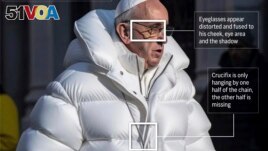27 March 2024
Fake photos, videos, and audio are spreading online as a result of the rise and misuse of artificial intelligence (AI) tools. And it is getting harder to tell what is real from what is not.
Video and image creators like DALL-E, Midjourney, and OpenAI's Sora make it easy for people with little technical skills to create "deepfakes."
The fake images might seem harmless. But they can be used to cheat people out of money, steal identities, spread propaganda, and unfairly influence elections.

The following photo-illustrated graphic highlights a few notable areas of an AI-deepfake of Pope Francis. (AP)
How to tell it is a deepfake
Just a year ago, the technology was far from perfect and it was easier to tell that a photo had been created with AI. Fake images then showed clear errors, like hands with six fingers or eyeglasses with different shapes.
But as AI has improved, it has become a lot harder.
Henry Ajder is founder of the AI advising company Latent Space Advisory and a leading expert in generative AI. He said some widely shared advice — like looking for unnatural eye movements in people in deepfake videos ­— no longer holds.
Still, there are some things to look for, he said.
Ajder said a lot of AI deepfake photos, especially of people, have a "smoothing effect" that leaves skin looking very "polished." He warned, however, that AI can sometimes change the photos and remove the signs of AI creation.
Look at shadows and lighting. Often the subject is clear and appears lifelike, but elements in the rest of the photo might not seem so real or polished.
Look at the faces
One of the most common deepfakes is exchanging one face for another. The practice is called face-swapping.
Experts advise looking closely at the edges of the face. Does the facial skin color match the rest of the head or body? Are the edges of the face sharp or unclear?
If you suspect video of a person speaking has been changed by AI, look at their mouth. Do their lip movements line up with the audio perfectly?
Cybersecurity company Norton says that the technology is not ready to create individual teeth. So Ajder suggests looking at their teeth. Are they clear, or are they unclear and somehow do not appear like they would in real life?
Sometimes the context of the photo is important. Take a minute to consider if what you are seeing could actually happen.
The Poynter journalism website advises that if you see a well-known person do something that seems unrealistic or unlike themselves, it could be a deepfake.
Using AI to find the fakes
Another method is to use AI to fight AI.
Microsoft has developed a tool that can study photos or videos and rate if it has been changed. Technology company Intel's FakeCatcher uses computer programs to study the smallest parts of an image, called pixels, to say if it is real or fake.
However, some of these tools are not available to the public. That is because researchers do not want to help bad actors improve their deepfakes.
All this being said, AI has been developing very quickly. And AI models are being trained on internet data to produce increasingly better content with fewer mistakes.
That means this advice to find deepfakes could be incorrect even a year from now.
Experts say it might even be dangerous to suggest the average person can find deepfakes. That is because even for trained eyes, it is becoming increasingly difficult.
I'm Gregory Stachel.
Kelvin Chan and Ali Swenson reported this story for The Associated Press. Gregory Stachel adapted it for VOA Learning English.
______
Words in This Story
fake – adj. not true or real
generative – v. to produce (something) or cause (something) to be produced
polished – adj. made smooth and shiny by polishing
shadow – n. a dark shape that appears on a surface when someone or something moves between the surface and a source of light
lip – n. either one of the two soft parts that surround the mouth
context – n. the situation in which something happens
exaggerated – v. to make (something) larger or greater than normal












